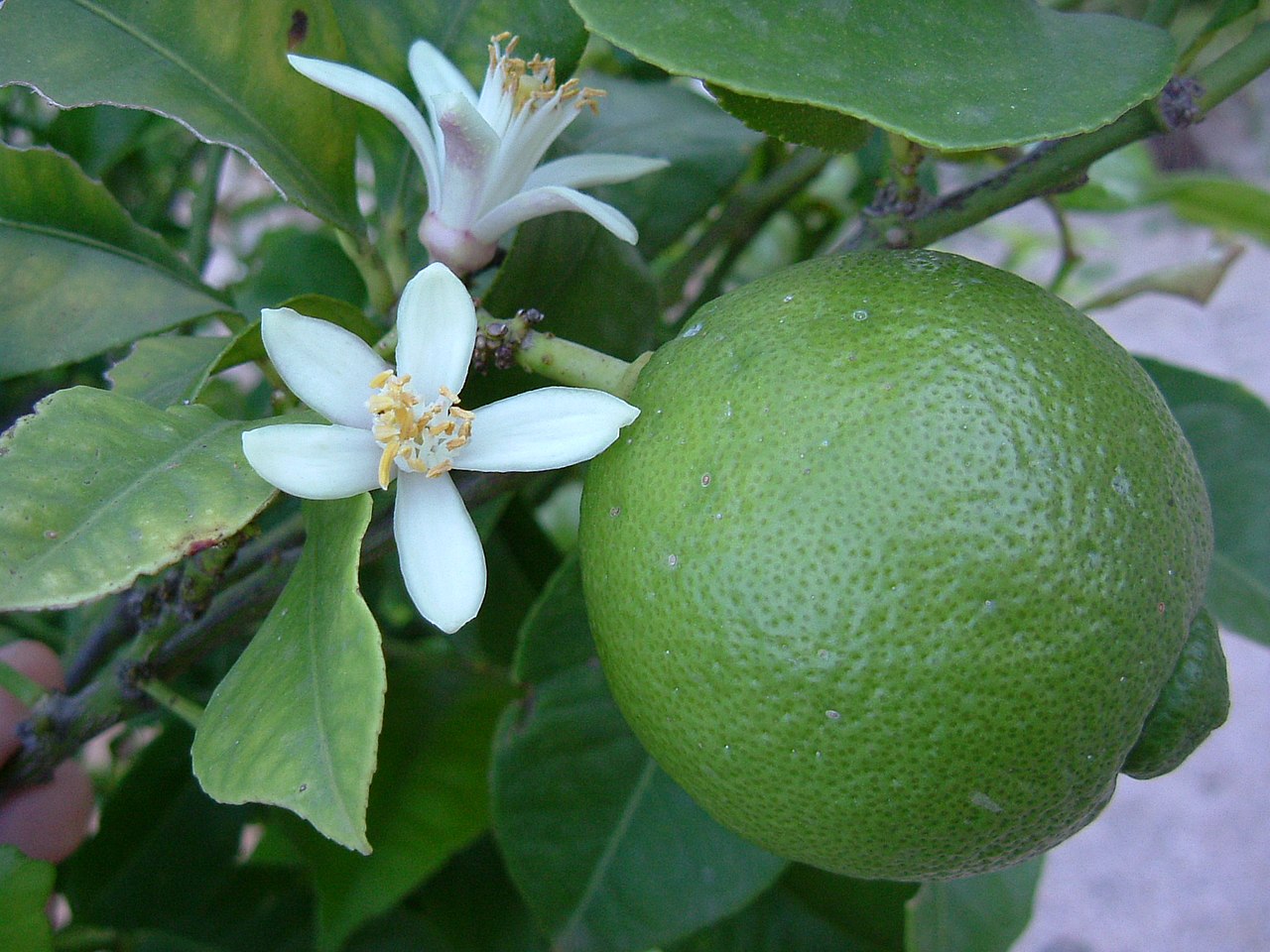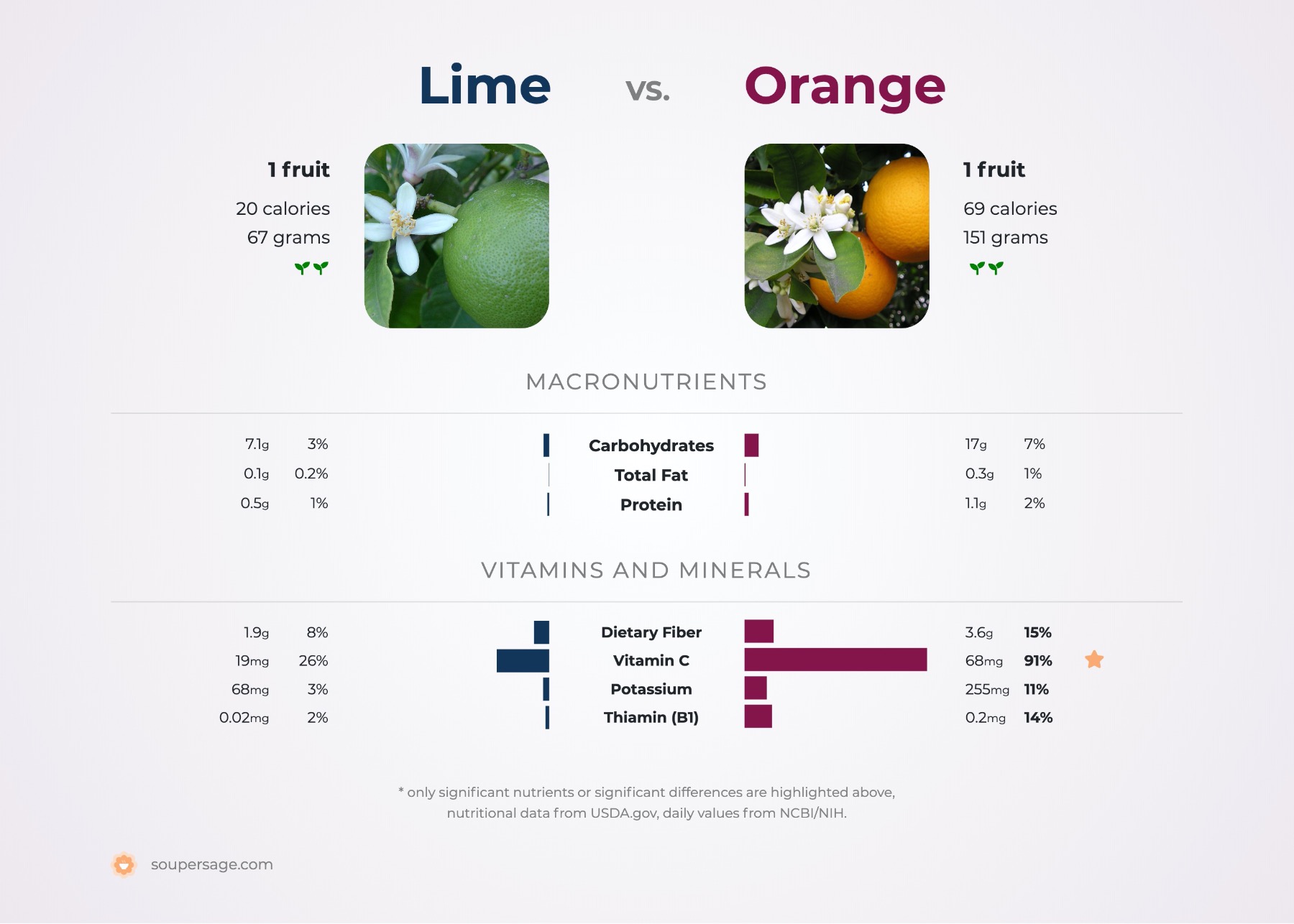Lime vs. Orange
Nutrition comparison of Lime and Orange
Ever wonder how your favorite foods stack up against each other in terms of nutrition?
We compared the nutritional contents of
lime
versus
orange
(100g each)
below using 2020 USDA and NIH data[1].
For a quick recap of significant nutrients and differences in lime and orange:
- Both lime and orange are high in Vitamin C and dietary fiber.
- Lime has 4.4 times less sugar than orange.
- Orange has more thiamin and niacin.
- Orange is a great source of calcium.
USDA sources for nutritional information: Lime (Limes, raw) and Orange (Oranges, raw, Florida) . Have a correction or suggestions? Shoot us an email.
Calories and Carbs
calories
Lime and orange contain similar amounts of calories - lime has 30 calories per 100 grams and orange has 46 calories.
For macronutrient ratios, lime is similar to orange for protein, carbs and fat. Lime has a macronutrient ratio of 6:90:4 and for orange, 6:91:4 for protein, carbohydrates and fat from calories.
Macro Ratios from Calories:
| Lime | Orange | |
|---|---|---|
| Protein | 6% | 6% |
| Carbohydrates | 90% | 91% |
| Fat | 4% | 4% |
| Alcohol | ~ | ~ |
carbohydrates
Lime and orange contain similar amounts of carbs - lime has 10.5g of total carbs per 100 grams and orange has 11.5g of carbohydrates.
dietary fiber
Both lime and orange are high in dietary fiber. Lime has 17% more dietary fiber than orange - lime has 2.8g of dietary fiber per 100 grams and orange has 2.4g of dietary fiber.
sugar
Lime has 4.4 times less sugar than orange - lime has 1.7g of sugar per 100 grams and orange has 9.1g of sugar.
Protein
protein
Lime and orange contain similar amounts of protein - lime has 0.7g of protein per 100 grams and orange has 0.7g of protein.
Fat
saturated fat
Both lime and orange are low in saturated fat - lime has 0.02g of saturated fat per 100 grams and orange has 0.03g of saturated fat.
Vitamins
Vitamin C
Both lime and orange are high in Vitamin C. Orange has 55% more Vitamin C than lime - lime has 29.1mg of Vitamin C per 100 grams and orange has 45mg of Vitamin C.
Vitamin A
Lime and orange contain similar amounts of Vitamin A - lime has 2ug of Vitamin A per 100 grams and orange has 11ug of Vitamin A.
Vitamin E
Lime and orange contain similar amounts of Vitamin E - lime has 0.22mg of Vitamin E per 100 grams and orange has 0.18mg of Vitamin E.
Vitamin K
Lime and orange contain similar amounts of Vitamin K - lime has 0.6ug of Vitamin K per 100 grams and orange does not contain significant amounts.
The B Vitamins
Orange has more thiamin and niacin. Both lime and orange contain significant amounts of riboflavin, pantothenic acid, Vitamin B6 and folate.
| Lime | Orange | |
|---|---|---|
| Thiamin | 0.03 MG | 0.1 MG |
| Riboflavin | 0.02 MG | 0.04 MG |
| Niacin | 0.2 MG | 0.4 MG |
| Pantothenic acid | 0.217 MG | 0.25 MG |
| Vitamin B6 | 0.043 MG | 0.051 MG |
| Folate | 8 UG | 17 UG |
Minerals
calcium
Orange is a great source of calcium and it has 30% more calcium than lime - lime has 33mg of calcium per 100 grams and orange has 43mg of calcium.
iron
Lime has 567% more iron than orange - lime has 0.6mg of iron per 100 grams and orange has 0.09mg of iron.
potassium
Orange has 66% more potassium than lime - lime has 102mg of potassium per 100 grams and orange has 169mg of potassium.
Antioxidants and Phytonutrients
carotenoids
Carotenoids are micronutrients commonly found in plants and some animal products. An example is beta-carotene, the notable carotenoid which is a popular source of Vitamin A.[4][5]
For specific types of carotenoids,
| Lime | Orange | |
|---|---|---|
| beta-carotene | 30 UG | 71 UG |
| alpha-carotene | ~ | 11 UG |
| lutein + zeaxanthin | ~ | 129 UG |
Omega-3 and Omega-6
omega 3s
For omega-3 fatty acids, both lime and orange contain significant amounts of alpha linoleic acid (ALA).
| Lime | Orange | |
|---|---|---|
| alpha linoleic acid | 0.019 G | 0.011 G |
| Total | 0.019 G | 0.011 G |
omega 6s
Comparing omega-6 fatty acids, both lime and orange contain small amounts of linoleic acid.
| Lime | Orange | |
|---|---|---|
| linoleic acid | 0.036 G | 0.031 G |
| Total | 0.036 G | 0.031 G |
Customize your serving size
The comparison below is by weight, but sometimes 100g isn't that intuitive of a measurement for food. View a custom portion comparison (e.g. cups, oz, package).
You can try adding or subtracting the amount of either Lime or Orange .
Lime g
()
|
Daily Values (%) |
Orange g
()
|
|||||
|---|---|---|---|---|---|---|---|
| KCAL % |
|
5% | calories | 5% |
|
KCAL % | |
| G % |
|
5% | carbohydrates | 5% |
|
G % | |
| G % |
|
5% | dietary fiber | 5% |
|
G % | |
| G | 5% | sugar | 5% | G | |||
| G % |
|
5% | total fat | 5% |
|
G % | |
| G % |
|
5% | saturated fat | 5% |
|
G % | |
| G | 5% | monounsaturated fat | 5% | G | |||
| G | 5% | polyunsaturated fat | 5% | G | |||
| G | 5% | trans fat | 5% | G | |||
| MG | 5% | cholesterol | 5% | MG | |||
| MG % |
|
5% | sodium | 5% |
|
MG % | |
| 5% | Vitamins and Minerals | 5% | |||||
| UG % |
|
5% | Vitamin A | 5% |
|
UG % | |
| MG % |
|
5% | Vitamin C | 5% |
|
MG % | |
| IU % |
|
5% | Vitamin D | 5% |
|
IU % | |
| MG % |
|
5% | calcium | 5% |
|
MG % | |
| MG % |
|
5% | iron | 5% |
|
MG % | |
| MG % |
|
5% | magnesium | 5% |
|
MG % | |
| MG % |
|
5% | potassium | 5% |
|
MG % | |
| MG % |
|
5% | thiamin (Vit B1) | 5% |
|
MG % | |
| MG % |
|
5% | riboflavin (Vit B2) | 5% |
|
MG % | |
| MG % |
|
5% | niacin (Vit B3) | 5% |
|
MG % | |
| MG % |
|
5% | Vitamin B6 | 5% |
|
MG % | |
| MG % |
|
5% | pantothenic acid (Vit B5) | 5% |
|
MG % | |
| UG % |
|
5% | folate (Vit B9) | 5% |
|
UG % | |
| UG % |
|
5% | Vitamin B12 | 5% |
|
UG % | |
| MG % |
|
5% | Vitamin E | 5% |
|
MG % | |
| UG % |
|
5% | Vitamin K | 5% |
|
UG % | |
| G % |
|
5% | protein | 5% |
|
G % | |
| UG % |
|
5% | biotin (Vit B7) | 5% |
|
UG % | |
| MG % |
|
5% | choline | 5% |
|
MG % | |
| MG % |
|
5% | chlorine | 5% |
|
MG % | |
| UG % |
|
5% | chromium | 5% |
|
UG % | |
| MG % |
|
5% | copper | 5% |
|
MG % | |
| UG % |
|
5% | fluoride | 5% |
|
UG % | |
| UG % |
|
5% | iodine | 5% |
|
UG % | |
| MG % |
|
5% | manganese | 5% |
|
MG % | |
| UG % |
|
5% | molybdenum | 5% |
|
UG % | |
| MG % |
|
5% | phosphorus | 5% |
|
MG % | |
| UG % |
|
5% | selenium | 5% |
|
UG % | |
| MG % |
|
5% | zinc | 5% |
|
MG % | |
| G | 5% | Water | 5% | G | |||
| G | 5% | Starch | 5% | G | |||
| G | 5% | Alcohol | 5% | G | |||
FAQ
Does lime or orange contain more calories in 100 grams?Lime and orange contain similar amounts of calories - lime has 30 calories in 100g and orange has 46 calories.
Does lime or orange have more carbohydrates?
By weight, lime and orange contain similar amounts of carbs - lime has 10.5g of carbs for 100g and orange has 11.5g of carbohydrates.


